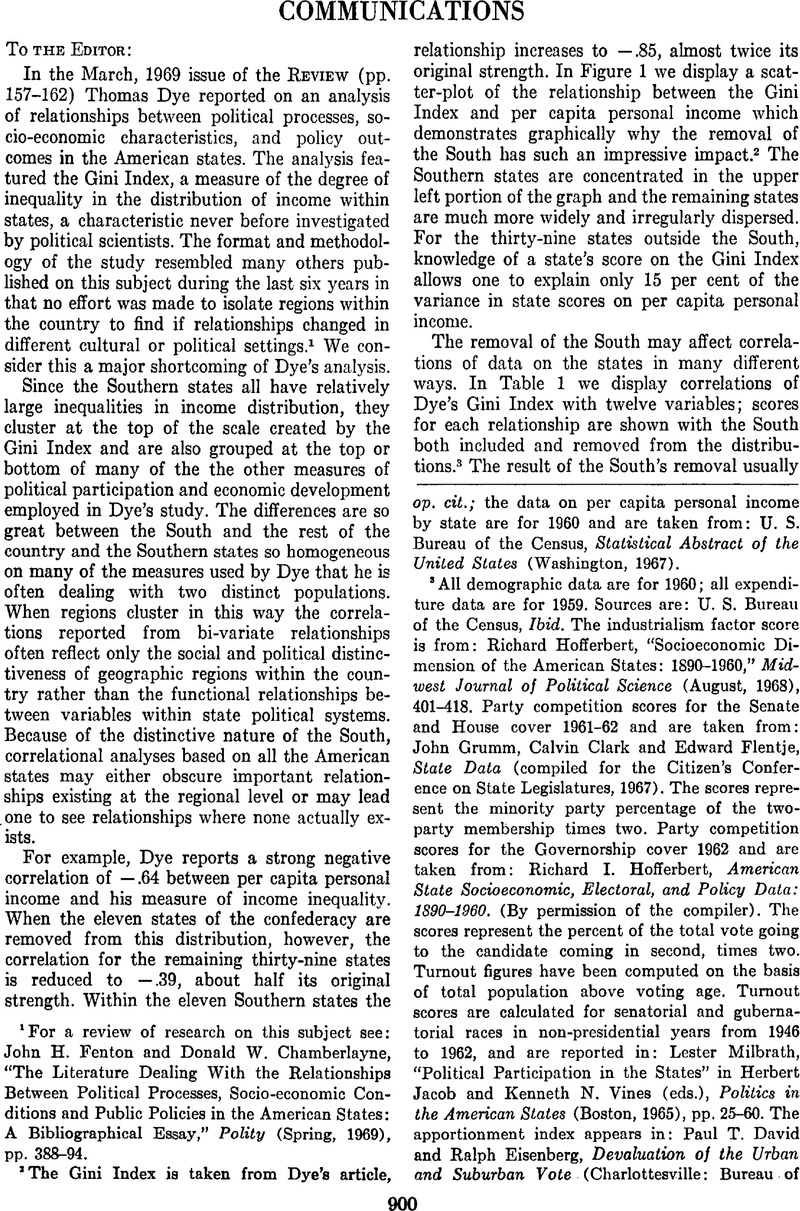Published online by Cambridge University Press: 01 August 2014

1 For a review of research on this subject see: Fenton, John H. and Chamberlayne, Donald W., “The Literature Dealing With the Relationships Between Political Processes, Socio-economic Conditions and Public Policies in the American States: A Bibliographical Essay,” Polity (Spring, 1969), pp. 388–94Google Scholar.
2 The Gini Index is taken from Dye's article, op. cit.; the data on per capita personal income by state are for 1960 and are taken from: U. S. Bureau of the Census, Statistical Abstract of the United States (Washington, 1967)Google Scholar.
3 All demographic data are for 1960; all expenditure data are for 1959. Sources are: U. S. Bureau of the Census, Ibid. The industrialism factor score is from: Hofferbert, Richard, “Socioeconomic Dimension of the American States: 1890–1960,” Midwest Journal of Political Science (August, 1968), 401–418 CrossRefGoogle Scholar. Party competition scores for the Senate and House cover 1961–62 and are taken from: Grumm, John, Clark, Calvin and Flentje, Edward, State Data (compiled for the Citizen's Conference on State Legislatures, 1967)Google Scholar. The scores represent the minority party percentage of the two-party membership times two. Party competition scores for the Governorship cover 1962 and are taken from: Richard I. Hofferbert, American State Socioeconomic, Electoral, and Policy Data: 1890–1960. (By permission of the compiler). The scores represent the percent of the total vote going to the candidate coming in second, times two. Turnout figures have been computed on the basis of total population above voting age. Turnout scores are calculated for senatorial and gubernatorial races in non-presidential years from 1946 to 1962, and are reported in: Milbrath, Lester, “Political Participation in the States” in Jacob, Herbert and Vines, Kenneth N. (eds.), Politics in the American States (Boston, 1965), pp. 25–60 Google Scholar. The apportionment index appears in: David, Paul T. and Eisenberg, Ralph, Devaluation of the Urban and Suburban Vote (Charlottesville: Bureau of Public Administration, University of Virginia, 1961)Google Scholar. The index of the formal powers of the governor can be found in: Joseph A. Schlesinger, “The Politics of the Executive,” in Herbert Jacob and Kenneth N. Vines (eds.), op. cit. pp. 207–237.
4 For recent analyses of regions within individual states see: Key, V. O. Jr. and Munger, Frank, “Social Determinism and Electoral Decision: The Case of Indiana,” in Burdick, Eugene and Brodbeck, Arthur J. (eds.), American Voting Behavior (Glencoe, 1959), pp. 281–299 Google Scholar; Wolfinger, Raymond and Greenstein, Fred I., “Comparing Political Regions: The Case of California,” this Review (March, 1969), 74–85 Google Scholar; and Elazar, Daniel J., American Federalism: A View From the States (New York, 1966)Google Scholar.
5 The importance of regions in the American political system has been recognized in several recent articles: Glenn, Norval D. and Simmons, J. L., “Are Regional Cultural Differences Diminishing?” Public Opinion Quarterly (1967), 176–193 Google Scholar; Sharkansky, Ira, “Economic Development, Regionalism and State Political Systems,” Midwest Journal of Political Science (1968), 41–61 CrossRefGoogle Scholar; and Walker, Jack L., “The Adoption of Innovations by the American States,” this Review (September, 1969)Google Scholar.
6 Dye, Thomas R., Politics, Economics and the Public (Chicago, 1966), p. 43 Google Scholar.
7 To check on this point a sample of eleven states was chosen from an alphabetical listing using a table of random numbers. Correlations of the Gini Index and several variables were then calculated using these new distributions. There were only small unsystematic changes in correlation coefficients based on distributions of fortyeight states and the eleven state sample, and no appreciable differences at all between the fortyeight state distributions and the thirty-seven state distributions.
Comments
No Comments have been published for this article.